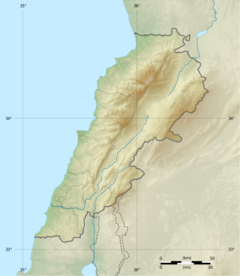| Commemorative stelae of Nahr el-Kalb | |
|---|---|
 A group of the inscriptions as depicted by Louis-François Cassas in 1799 | |
| Material | Limestone |
| Writing | Egyptian hieroglyphs, Assyrian cuneiform, Latin, Greek, Arabic, French and English |
| Created | c.1500 BC – AD 1946 |
| Present location | in situ |
Location in Lebanon | |
33°57′20″N 35°35′48″E / 33.955530°N 35.596696°E The commemorative stelae of Nahr el-Kalb are a group of over 20 inscriptions and rock reliefs carved into the limestone rocks around the estuary of the Nahr al-Kalb (Dog River) in Lebanon, just north of Beirut.
The inscriptions include three Egyptian hieroglyphic stelae from pharaohs including Ramesses II,[1] six cuneiform inscriptions[1] from Neo-Assyrian and Neo-Babylonian kings including Esarhaddon[1] and Nebuchadnezzar II,[1] Roman, Latin and Greek inscriptions, [1] Arabic inscriptions from the Egyptian Mamluk sultan Barquq[2] and the Druze prince Fakhr-al-Din II,[3] a memorial to Napoleon III's 1860 intervention in Lebanon[4] and a dedication to the 1943 independence of Lebanon from France.[4] As such, the site has been said to summarise all of Lebanon's history in one place.[5]
The earliest European to identify the site was the 17th-century traveller Henry Maundrell in 1697,[6][7] and Franz Heinrich Weissbach was the first editor of the inscriptions in 1922.[1]
In 2005, the stelae at the river were listed in the UNESCO Memory of the World initiative.[5]
- ^ a b c d e f Lipinski 2004, p. 1.
- ^ Britannica Al Kalb River
- ^ Cite error: The named reference
JWWwas invoked but never defined (see the help page). - ^ a b Commemorative stela of Nahr el-Kalb at Livius.org
- ^ a b UNESCO Memory of the World application
- ^ St. Chad Boscawen 1882, p. 333.
- ^ Robinson 1856, p. 623.
